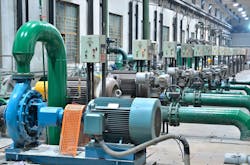Pumping liquid from one location in the process to another location in the process is a common hydraulic configuration encountered in processing systems. Not to be confused with pumping to multiple locations, this configuration is typically comprised of an originating vessel or tank, pump, flowmeter, destination vessel or tank, and their interconnecting piping.
Any of these components could potentially cause problems. For example, the vessel or tank sizes could be incorrect, the pump could exhibit cavitation, an improper flowmeter could be selected, and/or the interconnecting piping could be too big or too small. However, even when these items are correct, there is a distinct tendency to install the flowmeter near the pump — often with insufficient straight run, which can compromise flowmeter performance.
Straight run is one method that can be used to generate a good velocity profile entering the flowmeter. Straight run essentially provides space in which velocity profile distortion present in the liquid can dissipate. Standards and manufacturer recommendations detail straight run requirements for several flowmeter technologies for various upstream configurations. The problem is that this information typically focuses on piping configurations that might not include an upstream pump or the specific type of pump that is actually installed.
Pumps impart hydraulic energy into the fluid and can distort the velocity profile with strong eddies that take a long straight run to dissipate — especially in large pipes. There is an understandable general preference to install the pump on a solid foundation on the ground to be mechanically stable and provide ease of maintenance. There is also a tendency to locate the flowmeter immediately above the pump — especially when an instrumentation professional is not available for consultation. The installation may look nice, but locating the flowmeter one or two decks above the pump with more than sufficient straight run is advisable to reduce the probability that velocity profile distortion entering the flowmeter can adversely affect flowmeter accuracy.
David W. Spitzer is a regular contributor to Flow Control magazine and a principal in Spitzer and Boyes LLC offering engineering; seminars; strategic marketing consulting; distribution consulting; and expert witness services for manufacturing and automation companies. Spitzer and Boyes is also the publisher of the Industrial Automation INSIDER. Spitzer has more than 40 years of experience and has written more than 10 books and 300 articles about flow measurement, instrumentation and process control. He may be reached at 845-623-1830 or at spitzerandboyes.com.


